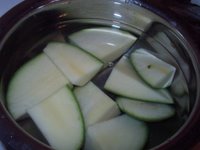 YAY! My second mango post of the year! Can you sense my excitement? The first dish was raw mango pulihora.
YAY! My second mango post of the year! Can you sense my excitement? The first dish was raw mango pulihora.Usually when things are made with raw mango, it is best to use mangoes that are a little sour. Using the sweet raw mango does not do justice to this dish and the pulihora.
Firstly, I want to explain what this Telugu recipe title means. The word "mamidikaya" means raw mango. The word pachi means, raw. Pulusu is used primarily for tamarind sauce. The word pulusu originated from the word "puli" in Tamil which means tamarind. In this case though, there is no tamarind involved. I have my own reasoning of why it is called pulusu though. This same exact dish is made with tamarind pulp instead of mango. Now, way back when, who ever discovered that this could be made with mango, decided to just throw in the word mango infront of the already existing regular "pachi pulusu" ;). I could be totally wrong, so don't take my word for this :).
This particular dish "pachi pulusu" is very common in the "Telangana" region of my state Andhra Pradesh. This is a very easy recipe, that is usually served cold with hot rice. I only make this simple, comforting dish once or twice a year that way I feel it doesn't loose it's "charm" :). That is just my theory though!
As soon as Indira of Mahanandi announced the Jihva event and announced May's theme (mangoes), two dishes came to mind. One of them was mango jam (Indira has already blogged about it) and this one! I was hoping Indira wouldn't make this before me.
 For the pulusu:
For the pulusu:Software
---------------
- 1 small-medium non-ripe mango (preferably sour)

- 1/4 cup finely chopped onions
- handful - chopped cilantro
- salt to taste
---------------
- One medium sauce pan
---------------
- Peel the mango and cut the mango into 2-3 inch slices. Put the pieces in the pan, add water so that all the mango pieces are well covered and the water is a couple of inches above the mangoes. Add salt, and boil the mango on medium-high heat until the mango breaks apart when touched with a fork.
- After the mango mixture is cold enough to handle, using a potato masher mash up the mango pieces or just use your hand and mash it up. I put 4-5 ice cubes in the mixture to ensure fast cooling.
- Add more water as necessary, so it has the soupy, rasam consistency. Add the onions and the cilantro. Keep aside.
Software
---------------
- 1 tbsp extra virgin olive oil
- 3-4 Indian green chilis, sliced legthwise in half
- 1 broken red chili pieces
- 1 tsp jeera seeds
- 1 tsp black mustard seeds
- 1 sprig curry leaves, cut in half
- 1/2 tsp turmeric powder
- 1/2 tsp coriander powder
---------------
- Small cast-iron skillet or a small saucepan
---------------
- Add the oil to the pan. Add the remaining ingredients, in the same order and turn off the heat after the mustard and jeera seeds splutter.
Serving Suggestion: This is best served with hot rice. It is also good after it rests for a couple of hours so the flavors get absorbed.
Update: In the above post, I first ask to peel the mangoes then boil them, but if you see the picture, I did not peel the mangoes before I boiled them. I did it the way mom does it back home. After the mangoes are mashed up the skin is extracted out and discarded. Since that seemed like a cumbersome method than first peeling and boiling the mangoes, I wrote up the post that way! I am surprised that no one noticed it and asked me about it :)!




















